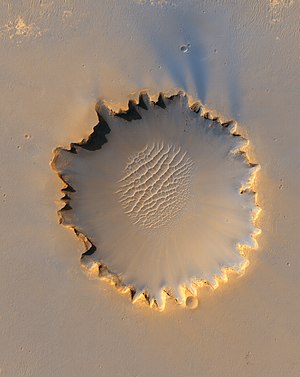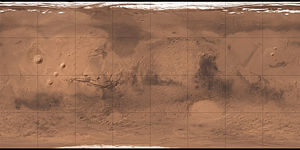Victoria (Mars crater)
| Martian crater Victoria | ||
|---|---|---|

|
||
| Victoria crater from above | ||
|
|
||
| position | 2 ° 3 ′ S , 5 ° 30 ′ W | |
| diameter | 730 m | |
| depth | 70 m | |
| history | ||
| Eponym | Victoria (1519) | |
The Victoria Crater is an impact crater , the W and 2.05 ° S in is 5,50 ° Meridiani Planum on Mars is. He was visited by the Rover Opportunity . With a width of approx. 730 m and a depth of 70 m, it is almost eight times larger than the Endurance crater . The Victoria Crater was named after the ship Victoria , one of five ships owned by Ferdinand Magellan and the first ship to sail around the world.
The Victoria crater is very interesting for the scientists because it offers the possibility of examining deeper geological structures of the surface with the Rover Opportunity , which allow conclusions to be drawn about the development history of Mars. Up to 30 m thick layers of sediment are exposed on the steep slopes of the crater .
It took Opportunity 21 months to reach Victoria Crater on September 26, 2006 ( Sol 951) in Duck Bay. Other objects in the vicinity of the crater were named: "No Name", "Duck Crater", "Emma Dean", "Maid of the Canyon" and "Kitty Clyde's Sister".
On August 29, 2008, Opportunity drove out of the crater and continued its way to the Endeavor crater about 12 km away , which it reached in August 2011.
Investigation results
At the crater, steep cliffs and shallow indentations alternate along the rim. Based on these structures, it can be estimated that the crater used to be smaller than it is today and that it was widened by 25 percent due to wind erosion. It was also filled with sand. The cliffs show rocks with layer structures that are up to 9 m thick. The visible layer patterns indicate that these rocks are former shifting dunes that later solidified to sandstone under the influence of water.
The so-called "blueberries" were also found in the rocks of the Victoria crater. These stone spheres were found all over the Meridiani plain. They usually form when water penetrates rocks. Since the spheres in the lower layers of the crater are larger than those in the layers above, it is assumed that the influence of the groundwater was more intense in the lower layers.
Meteorite fragments were found on the edge of the crater, which may have belonged to the impactor that created the crater.
When examining the indentation called "Duck Bay", it was found that the lower layers differ in chemical composition from the upper layers (the lower layers contain less sulfur and iron, but more aluminum and silicon). This dichotomy was also found in the Endurance crater 6 km away. From this it can be concluded that the environmental conditions that changed the rock had a regional character and not only had a local effect.
panorama
See also
Web links
- Official Mars Rovers website
- NASA Rover Opportunity Takes First Peek Into Victoria Crater .
- Google infrared map centered on Victoria Crater
- Victoria Crater relative to MER-B landing ellipse
Individual evidence
- ^ NASA Rover Sees Variable Environmental History at Martian Crater. NASA / JPL, May 21, 2003, accessed January 27, 2010 .
- ^ SW Squyres et al .: Exploration of Victoria Crater by the Mars Rover Opportunity . In: Science . 2009, doi : 10.1126 / science.1170355 .

